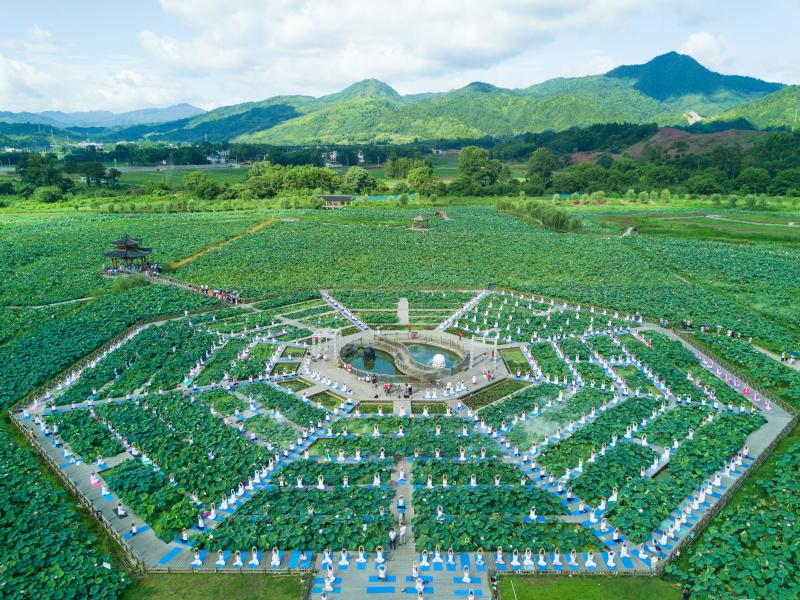Duet of Yoga and Taiji
- By Manisha Chakraborty
 0 Comment(s)
0 Comment(s) Print
Print E-mail China.org.cn, June 21, 2019
E-mail China.org.cn, June 21, 2019

"To One Who Has Been Long in City Pent" in today's high-stress living environment, India's prescription is sacred "Yoga" while China has long prescribed to the intangible cultural heritage of "Taiji" ( or Tai Chi).
The rich cultural influences of the two countries have made outstanding contributions to the world. They also reveal striking similarities in the fields of cultural forms and philosophical thinking. China has developed its unique Taiji culture, while India relies on longstanding Yoga culture. Although following different practices, these two age-old pearls of Oriental civilization have been making life beautiful since ancient times.
The benefits of Yoga will take center stage once again when the world celebrates the fifth edition of International Yoga Day (IYD) on June 21, the theme this time being "Yoga for the Heart." The day reminds the world to stay fit, mentally and physically.
During his speech at the United Nations General Assembly (UNGA) on September 27, 2014, India's Prime Minister Narendra Modi proposed the idea of celebrating the impact of Yoga on our lives every June 21 as it is the longest day of the year in the Northern Hemisphere and shares special significance in many parts of the world.
The first IYD was observed globally on June 21, 2015, and more than 30,000 people, including Prime Minister Modi, performed yoga "asanas" (postures and poses) at Rajpath, a major boulevard in New Delhi.
Originated in India over 5,000 years ago, Yoga is Indian civilization's gift to the world. It does not just help in building flexibility and strength, but it is also a spiritual exercise in the country of its birth. It's heartening to see that, today, millions of people use Yoga exercises as "health insurance for a zero budget" in more than 180 countries and regions.
After its inception in 2015, the IYD is celebrated in a big way with thousands participating in mass Yoga events from the glass bridge in south China's Shuanglonggou forest park in Liuzhou to New York's iconic Times Square, from the landmark Eiffel Tower in Paris to the European Union Parliament, and from the U.N. headquarters to even at the top of the famed Sydney Harbor Bridge.
The growing popularity of Yoga and the influence of Yoga gurus in the West proves the power of this Indian legacy passed down by the ancients for the betterment of humankind. It is now being seen as an effective stress-buster, a natural treatment of achieving mind and body fitness in today's fast-paced environment.
It's a matter of pride that Yoga fever has gripped China in recent years vying with its own national treasure Taiji. This was evidenced as thousands of Yoga lovers participating in scores of events organized across China to form the second biggest celebrations of the first IYD in the world after India in 2015.

The first yoga college outside India has emerged with collaboration of India and China at Yunnan Minzu University in Kunming, becoming a cultural milestone between the two nations. The university is now offering China's first Master's Degree in Yoga, officially approved by the Ministry of Educational in January 2017.
In the third year of IYD in 2017, yoga was performed for the first time atop the Great Wall by a joint Indian and Chinese group of yogis (male practitioners) and yoginis (female).
A Yoga event was organized for the first time at the Shanghai Cooperation Organization (SCO) headquarters in Beijing on June 17 last year. The official newspaper Global Times reported that Yoga even had entered the public school system in some cities across China. There are currently 10,800 yoga schools across the country.
On the other hand, Taiji has been gaining recognition in all age groups in India for its numerous health benefits. Like Yoga, Taiji with its historical origins in ancient Chinese philosophy of Taoism also creates a bond between the body and mind, apart from all the other recognized benefits. At the beginning of 2018, two sub-centers of the China-India Taiji College of Yunnan Minzu University were established in India and have trained about 1,000 Indian teachers.
The practices of Taiji and Yoga may differ, but the two ancient disciplines can deepen Sino-Indian friendship. Undoubtedly, the duet of Taiji, calligraphy, the tea art of China and Yoga, the music, movies and dances of India can contribute to the friendship, economic and cultural exchanges and cooperation between the two great nations.
China's love for Yoga and India's love for Taiji could also be a new direction for China-India cooperation.
Manisha Chakraborty is the cultural secretary at New Horizon Radio Listeners' Club, based in West Bengal, India.
Opinion articles reflect the views of their authors, not necessarily those of China.org.cn.
If you would like to contribute, please contact us at opinion@china.org.cn.






Go to Forum >>0 Comment(s)